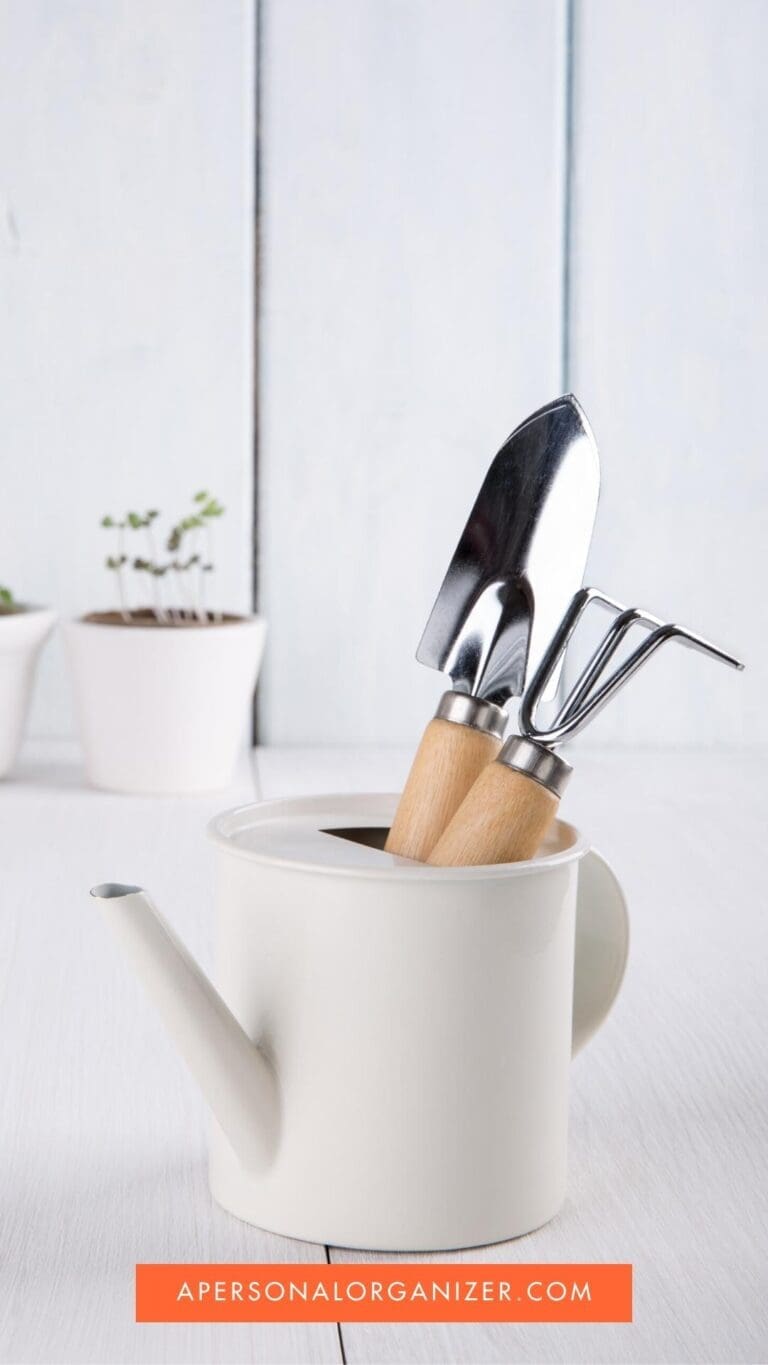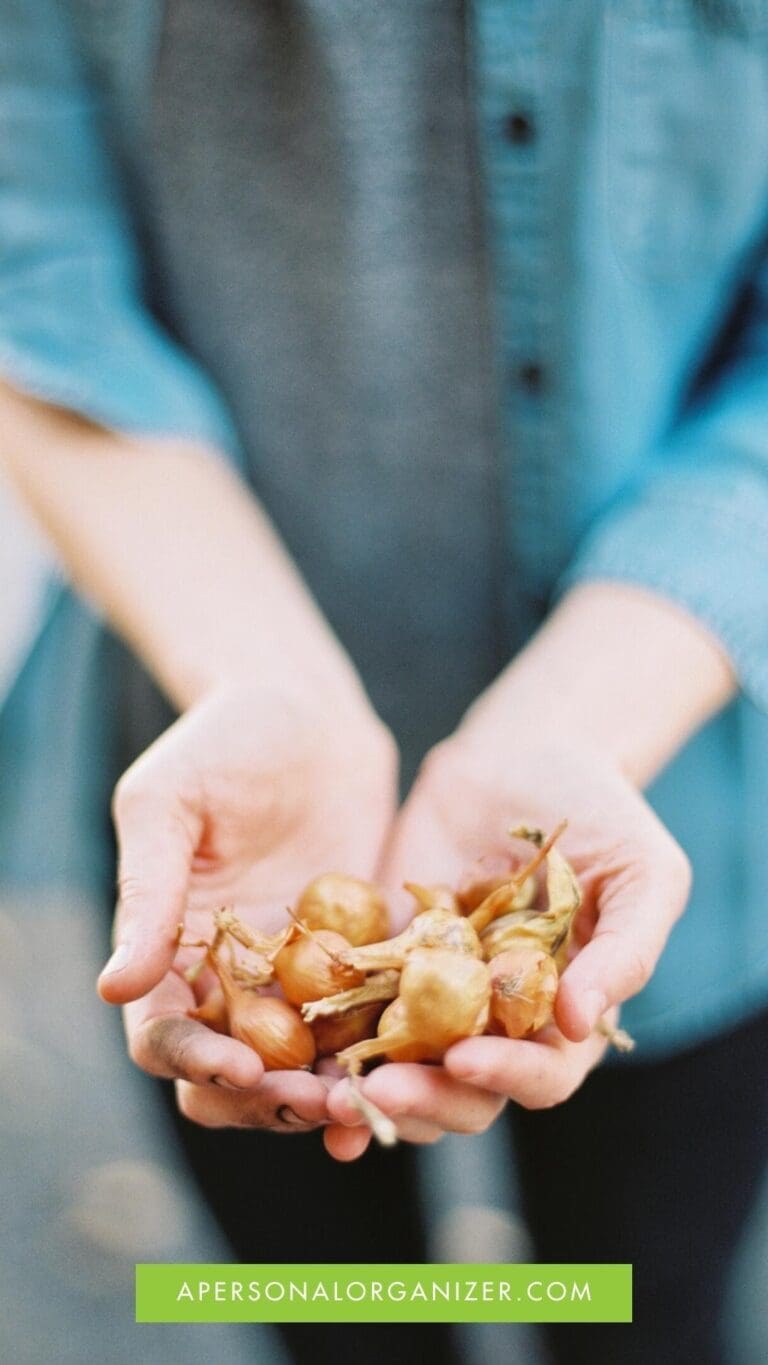This post may contain affiliate links for your convenience. As an Amazon Associate, A Personal Organizer, LLC earns from qualifying purchases.
Starting a home garden is easy. Here are 10 steps to create the garden of your dreams and enjoy fresh, healthy vegetables.
Many people love the idea of having an at-home garden and enjoying fresh, homegrown vegetables. However, most people stop short of realizing their dream garden because they perceive gardening as a difficult task that not everyone can do. In reality, this couldn’t be further from the truth!
In my family’s case, the COVID-19 pandemic hit right when we decided to try and start a garden. This ended up being a happy coincidence, as my family found that planting and tending to our garden was a great therapeutic activity during those stressful days.

Now, this will be our third year planting a garden. My family and I love tending to it and the results that follow.
I am not an expert gardener, but my experiences with our garden and my background as a personal organizer have helped me come up with a short and easy list of steps for starting your dream garden. So here are ten easy steps to help you create a garden at home.
If you need help further organizing your garden, check out my garden planner here! It will make gardening for beginners super easy.
Choose What Plants You’d Like to Grow.
The first step to starting a garden is choosing precisely what you want to plant. The choices can seem endless: do you want a garden that produces vegetables? Flowers? Some of both?
In the end, you can choose to plant anything in your garden that your heart desires. However, there are a few things you should keep in mind before committing to your plant selection.
First, consider what plants can actually grow and thrive in your climate. Many plants can only survive in specific environments, so before choosing any plant, do some research to make sure it will be able to grow.
Second, check the maintenance of each plant you wish to use. Some plants are designed for beginners and are much less demanding than their more complicated plants. The best advice is to start easy and work your way up to plants that require more care.
Once you consider these two points, look at what you and your family eat—there is no need to spend money and time growing something no one likes. You might have dreams of finally making the kids eat kale, but if they hate it, you might be wasting a precious spot in your garden to plant something everyone loves.
If you, like me, LOVE flowers and would like to plant some to create flower arrangements for your home, consider which types you love and plan to have room for them. I like to plant not only the flowers I love but to consider when they bloom so I always have something blooming and new in the garden.
Choose the Best Spot for Your Garden
Next, you need to choose the best spot for your garden. You need to consider the amount of sunlight and protection your plants need.
Many plants need 6-8 hours of sunlight, so make sure that your garden spot isn’t in the shade all day. Also, make sure that your garden area will be protected from your local wildlife — rabbits and foxes love to eat our vegetables. Check to see what the plants you want to grow specifically need to thrive before choosing the best spot for your garden.
Clear the Ground
Now that you have the spot where you wish to start a garden, it’s time to clear the ground for your beds. This process may vary depending on what type of garden beds you use. Overall, you need to remove any rocks, weeds, sod/grass, or other impurities from the area you plan to plant.
Test and Improve Your Soil
Once your ground is ready, you need to test your soil and see if it needs improvement. The biggest thing you need to find out is your soil’s PH, and this can be done with DIY kits. Depending on what you want to grow, you may need a different soil PH.
Once tested, improve your soil for planting by adding organic matter such as worm castings and loosening any soil to moisten slightly. As a rule of thumb, your soil should be moist enough to form a loose ball when squeezed in your fist but dry enough so that it falls apart once released.
Prepare Your Garden Beds
Now, you need to construct or prepare your garden beds. The two most popular options for home gardens are raised and sunken beds.
Raised beds are great because they take up less space and are easy to access. However, since they are not in the ground, they often dry out quickly and can be challenging to care for. If you live in a low moisture climate, having a sunken bed embedded in the ground can help your plants maximize their environmental moisture.
Make sure that your beds are in a grid pattern with walkways and plenty of room for each plant to grow. Don’t crowd your plants!
In our first year, out of an abundance of enthusiasm, we planted too many cucumber plants. While we loved them, our garden became a wild jungle!
Choose the Right Plants/Seeds
It is finally time to purchase the plants and seeds for your garden! Remember, you should already know what plants you will put in your garden before doing anything else.
There are two ways to start this process: from seeds or small plants.
You can buy young plants from a local nursery and transplant them into your garden. Seeds can be ordered from a seed catalog or purchased locally but require you to start earlier and inside.
If you decide on young plants, read about them before heading to the store to know what to look for. You want to come home with the healthiest plants out there!
I have never grown our plants from seeds, but my mother-in-law does it every year, and she starts early in the year. If this is your first garden, I’d say go to the nursery and by yourself some baby plants. Then, next winter, and based on what you enjoyed and what worked for you, you can work on your seeds.
Start Planting
Now, after all this work, you can begin planting your garden! Before digging a hole in your bed, check if your seeds/plants have planting instructions. Most of them will have at least basic guidelines to follow and if you’re an amateur gardener like me, follow the instructions. 😀
Generally, you want to plant seeds roughly three times as deep as the seed’s diameter. Each variety of plant and seed is unique and may need to be planted in different seasons, so make sure to stay organized and pay attention to any labels or instructions.
My tip is, if you’re buying your seeds in Winter, open your calendar and write down when you’ll plant them to follow the instructions. You don’t want to find your seeds packages when the time to plant them has passed.
Carefully Water Your Garden
After carefully planting your seeds, it’s probably time to water your garden for the first time. Most seeds need to be watered almost every day until becoming fully grown plants.
As your plants begin to grow, you will need to water less or more, depending on your local climate and soil conditions. As a basic rule of thumb, most plants need about one inch of water per week during the growing season. Don’t forget that rain replaces your watering can, so don’t overdo it.
As my landscaper explained to me once: watering your plants after days of rain is like letting your baby sit on a wet diaper for many hours. I never forgot that and couldn’t help imagining the roots of my beautiful plants endlessly soaking in a bed of water.
Maintain Your Garden
There’s more than water for a healthy garden, and this is the part I love the most: to tend for the plants and soil.
You’ll find yourself in a routine of watering your plants regularly, and now you need to make sure that your garden stays protected.
If you have deers, rabbits, and the like in your area, make sure you have good boundaries to stop them from eating your plants.
These boundaries could include fences, walls, screens, etc. You should also promptly get rid of any weeds before they seed. If you spot bugs in your garden, manually remove them and consider anti-bug treatments.
My dad used to plant mint around the beds on his ranch, and my mother-in-law plants marigolds around her tomatoes. I like these chemical-free solutions best.
Enjoy the Bounties of Your Garden!
After all that hard work, it’s finally time to enjoy the bounties of your at-home garden!
Check on your garden regularly, and enjoy the fruits, vegetables, and beautiful flowers as they start to grow! When harvesting vegetables, pay attention to how they need to be clipped/cut. Some vegetables like lettuce can simply be snipped off, while others need to be cleared before more grows.
If you love growing your veggies as much as we did, check out the Garden Planner in our Etsy Shop!
Organizing Planners
The Garden Planner
From seed, tools, and plant inventories to shopping lists for all your gardening needs and planning.
Shop Gardening Tools
While there are endless possibilities for tools and gardening, I always go back to the basics: my tote with my tools, a kneeling pad, and very good gloves.















